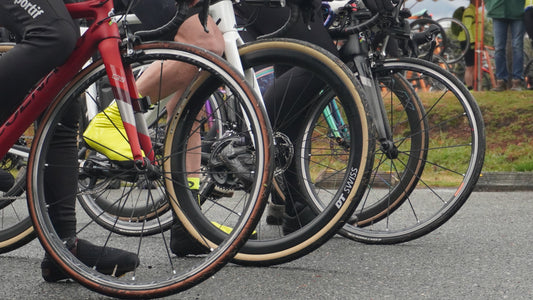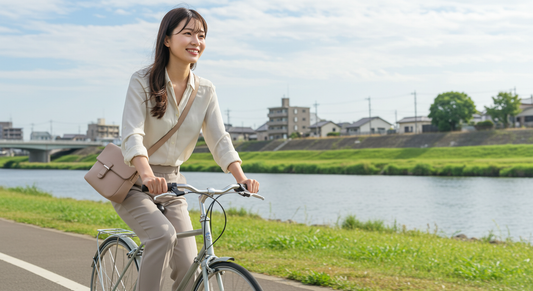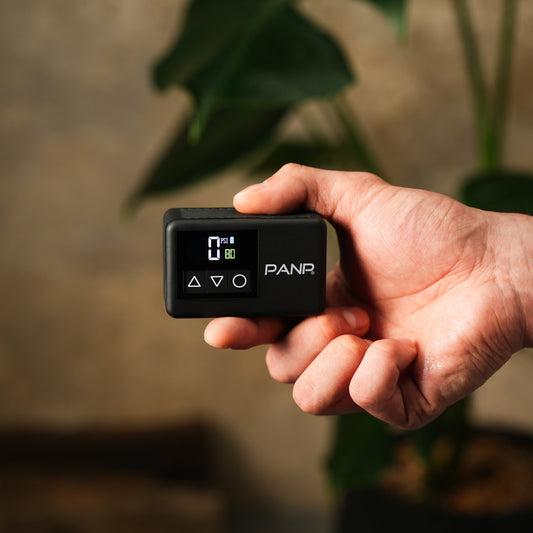Ride comfort changes with air pressure
Whether you're commuting or cycling every day, you may feel like your pedals are heavy or you feel the impact of bumps . If you're experiencing these discomforts, your tire pressure may actually be the cause.
Tire pressure is a factor that has a significant impact on ride comfort, safety, and physical strain . In this article, we will explain in detail how proper tire pressure can provide a comfortable driving experience and how to maintain it.
Why is air pressure important?
What is the proper air pressure?
Every tire has a recommended "proper inflation pressure," usually listed on the side of the tire and expressed in PSI or kPa.
This value is the standard that provides the most balanced riding performance , and you can further increase comfort by fine-tuning it according to the riding situation, your weight, etc.
The effect of air pressure on driving performance
If the tire pressure is not correct, the following effects will occur:
- Too much air pressure: Reduced shock absorption, increased vibration, and reduced grip.
- Too low air pressure: harder to pedal and increased risk of punctures.
Risk of excess or shortage
The impact of air pressure is particularly noticeable when carrying children or a lot of luggage. Insufficient air pressure can cause the tire to deform significantly, leading to rim strikes, punctures, and accidents .
Air pressure adjustment for a comfortable ride
Guidelines by tire type
Different types of tires have different recommended inflation pressures, the following are general guidelines:
- City bike: 40-60 PSI
- Cross bike: 60-85 PSI
- Road bike: 90-120 PSI
- Electric bicycles: 50-70 PSI
The difference in comfort you can experience
Maintaining the proper air pressure makes pedaling easier, driving quieter, and reduces vibration to the hands and waist , resulting in a ride that is gentler on the body.
The optimum air pressure for each situation
- Commuting: If you have a lot of luggage, higher tire pressure will improve stability.
- Long rides: Set it slightly lower for better cushioning.
- Rainy days: Medium to low pressure is recommended for grip.
View by category | Comfort and peace of mind brought by air pressure
Driving comfort is determined by "air pressure"
Although it may not be obvious from the outside, proper tire pressure contributes to a comfortable and safe ride . Lighter ride, less impact, less prone to punctures - all of these can be affected by managing tire pressure.
By category | Proper air pressure and its effects
| Categories | Proper air pressure (PSI) | Purpose | Benefits of air pressure |
|---|---|---|---|
| City Cycle | 40-60 | Commuting, shopping | Light and smooth pedaling. Less likely to get a flat tire. |
| Road bike | 90-120 | Long distance/paved road | Less resistance makes it easier to maintain speed. Less fatigue. |
| Gravel bike | 35 to 50 | Forest roads and unpaved roads | Easy to absorb shock and less vibration |
| Car (regular car) | 30-36 | Daily driving | Stable handling. Prevents uneven tire wear. |
Proper tire pressure brings you peace of mind
Proper tire pressure management is a small habit that can make your daily commute more comfortable and safer .
It also helps tires last longer and makes for a less tiring ride, making it a choice that is kind to both your body and your equipment.
With the RIDE series, you can adjust the air pressure while inflating!
With RIDE, you can set the air pressure and fill your tires with the perfect amount of air.
This is the perfect pump to make your everyday rides more comfortable.
Click here for product details

How to Adjust Air Pressure According to Seasonal Temperatures and Humidity
Air pressure is something that changes
Tire pressure is constantly fluctuating due to changes in temperature and humidity .
In particular, a 1°C change in temperature is said to result in a change of approximately 0.2 to 0.3 PSI , and air pressure naturally fluctuates with the change of seasons.
Spring and Autumn: The most stable seasons
Spring and autumn are times when temperatures are intermediate and stable, making it easy to adjust tire pressure .
However, the temperature difference between day and night can be large, so if you feel like the air has leaked out in the morning, it is a good idea to refill it frequently .
Summer | Air tends to expand due to high temperatures
In summer, the air inside the tires tends to expand due to rising road temperatures and sunlight.
For this reason, the air pressure tends to be higher , and if it exceeds the upper limit, the shock absorption performance will decrease, which may cause the tire to burst or wear out.
On hot days, it is safer to set the tire pressure at a slightly lower level (-5 to 10%) .
Winter | Air tends to shrink in the cold
In winter, the air contracts and the air pressure naturally drops .
If left unchecked, the tire pressure will fall far below the recommended value, increasing the risk of a flat tire. In cold weather, it is recommended to increase the tire pressure by 5 to 10% .
In addition, ensuring grip is important on snowy or icy roads, so maintaining pressure that is not too low leads to safety.
Does humidity have an effect?
Although humidity itself does not have a direct effect on air pressure, the more moisture there is in the air, the more sensitive it is to temperature changes .
Therefore, during the rainy season and humid summer months , atmospheric pressure changes can occur quickly , so it is best to check it frequently, about once a week .
Seasonal | Tire pressure adjustment guidelines (table)
| season | Features | Adjustment guidelines | Check frequency |
|---|---|---|---|
| spring | There is a difference in temperature between day and night | Maintain basic values. Beware of drops in the morning | Once a week |
| summer | Tends to expand at high temperatures | Aim for 90-95% of the upper limit | 1-2 times a week |
| autumn | As stable as spring | In preparation for the temperature starting to drop, add a little more | Once a week |
| winter | Cold weather causes contraction and low pressure | Approximately +5 to 10% above the recommended value | 1-2 times a week |
The key to a comfortable ride is to make flexible adjustments according to the season
In order to ride comfortably and safely throughout the year, it is very important to "adjust the air pressure to suit the current season."
With regular checks and fine-tuning, your ride will be smoother and safer.
Summary | Habits to make your cycling life more comfortable
Adjusting tire pressure may seem like a mundane task, but it is an important factor in creating comfort, safety, and reliability .
Just a few minutes of checking and adjusting can make your cycling life much more comfortable.
Why not start paying attention to air pressure today?




